|
|
|
|
|
Oil On
Canvas, Real Flavor of Old Masters
|
|

|
ARTWORKS
INDEX
A B C D E F G H I J K L M N O P Q R S T U V W X Y Z |
ARTISTS
INDEX
A B C D E F G H I J K L M N O P Q R S T U V W X Y Z |
|
|
| | |
|
|
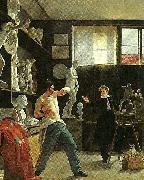 |
wilhelm bendz -- Click Here
|
|
(March 20, 1804 ?C November 14, 1832), Danish genre and portrait painter, is one of the main personages associated with the Golden |
|
 |
Wilfred vincent herbert -- Click Here
|
|
fl.1863-1891
Parce Alteri |
|
 |
WILDENS, Jan -- Click Here
|
|
Flemish Baroque Era Painter, 1586-1653
Flemish painter and draughtsman, active also in Italy. He was an important and proficient landscape painter who worked with Rubens and other masters in Antwerp. |
|
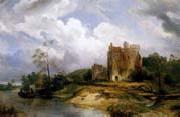 |
Wijnand Nuyen -- Click Here
|
|
Dutch Painter, 1813-1839, Dutch painter and printmaker who specialised in landscapes, and was greatly influenced by the French Romantics. Born to a baker father who recognised his son's talent, Nuijen was apprenticed at age twelve to Andreas Schelfhout in Den Haag. Between 1825 and 1829 he studied at the Den Haag Tekenacademie, under Bartholomeus Johannes van Hove. In his short lifespan Nuijen turned into a prolific painter of rural and marine landscapes, spending much time on the Normandy and northern French coasts. Here he fell under the spell of painters who were working in France, such as Richard Parkes Bonington (1802-1828) and Eugene Isabey (1803-1886), both of whom painted picturesque villages, Normandy harbours and seascapes, with a spontaneity Nuijen admired and adopted. His preoccupation with ruins is typically Romantic and his use of colour and texture is reminiscent of the watercolours of Turner. The Felix Meritis society of Amsterdam awarded him a medal in 1829 for his watercolour of a forest landscape. On completion of his tuition he travelled to Belgium, France and Germany, at times with his painting companion Antonie Waldorp [1803-1866]. Nuijen became a member of the Koninklijke Akademie in Amsterdam in 1836, and just before his death he married the daughter of Schelfhout, his former tutor. Nuijen was unusual among Dutch painters of the period, his theatricality and liberal style contrasting with the near photographic depiction that was then the norm. King William II greatly admired Nuijen's work and bought the "Shipwreck" in 1843, |
|
 |
WIERINGEN, Cornelis Claesz van -- Click Here
|
|
Dutch painter (b. ca. 1580, Haarlem, d. 1633, Haarlem)
Dutch draughtsman, painter, etcher and navigator. His name first appears in the Haarlem records in 1597. It is generally assumed that he was a pupil of Hendrick Vroom, whose work strongly influenced his own. Documentary sources confirm that he maintained close friendships with both Hendrick Goltzius, who made woodcuts after his drawings (see fig.), and Cornelis Cornelisz. van Haarlem. Van Wieringen was more than once governor of the Haarlem Guild of St Luke, a position in which he was responsible for updating the guild's outmoded organization. He specialized in seascapes and received commissions from the city of Haarlem, the Dutch Admiralty in Amsterdam and others. His interest lies primarily in his influence on Dutch marine painters of the 17th century. |
|
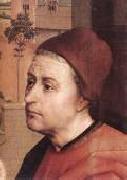 |
WEYDEN, Rogier van der -- Click Here
|
|
Netherlandish Northern Renaissance Painter, ca.1400-1464
major early Flemish master, known also as Roger de la Pasture. He is believed to have studied with Robert Campin. His early works also show the influence of Jan van Eyck. Van Eyck, however, had been a master at objective rendering of detail, whereas Roger in his work portrayed emotions with an assurance that has not been surpassed. His ability to depict piety is reflected in the early masterpiece Descent from the Cross (c.1435; Prado); he depicted with significant restraint the profound grief of the mourners grouped around the tragic figure of Jesus. His composition strongly affected later representations of the theme. Roger became City Painter in Brussels in 1436. He then produced a series of undated altarpieces including the Last Judgment (hospital, Beaune), the Braque Triptych (Louvre), Crucifixion with Donors (Vienna), and Adoration of the Magi (Berlin), which vary in execution from a stress on sumptuous details to a more sculptural rendering of the figures. Roger is believed to have made a pilgrimage to Italy in the holy year 1450. Whether this supposed excursion had any effect on his style is much debated. It has been shown that his Entombment (Uffizi) bears an affinity to the Tuscan treatment of the subject, particularly by Fra Angelico, and that Roger's Virgin and Child with Saints (Frankfurt) has a strong resemblance to the Italian religious art of the day. His style is, however, highly individual. His religious paintings and his portraits are characterized by a straightforward monumentality. The portraits, such as that of a young lady (National Gall. of Art, Washington, D.C.) and of Francesco d'Este (Metropolitan Mus.) exhibit a simple clarity of contour and psychological penetration. Other notable works are his St. Luke Painting the Virgin, of which a version or replica is in the Museum of Fine Arts, Boston, the Crucifixion |
|
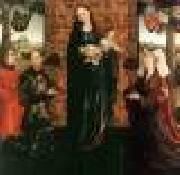 |
WEYDEN, Goossen van der -- Click Here
|
|
Flemish painter (b. ca. 1465, Bruxelles, d. after 1538, Antwerpen) |
|
 |
WET, Gerrit de -- Click Here
|
|
Dutch painter, Amsterdam school (c. 1616 - 1674, Leyden)
|
|
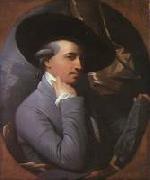 |
WEST, Benjamin -- Click Here
|
|
American Neoclassical Painter, 1738-1820
American historical painter who worked in England. He was born in Springfield, Pa., in a house that is now a memorial museum at Swarthmore College. After some instruction from a local artist named William Williams, he set up as a portrait painter in Philadelphia at 18, subsequently moving to New York City. In 1760 he went to Europe, where he remained for the rest of his life. For three years he studied in Italy. Working under the tutelage of Anton Mengs, he was also inspired by the classical research of Johann Winckelmann. He then settled in London, becoming a leader of the neoclassical movement. Under the patronage of George III, commissions came to him in great numbers, and in 1772 he was appointed historical painter to the king. A founder of the Royal Academy, he succeeded Sir Joshua Reynolds as its president in 1792. West executed more than 400 canvases, chiefly historical, mythological, and religious subjects painted on a heroic scale. He had many pupils and was a generous friend and adviser to younger artists, particularly American painters studying in England, among whom were Washington Allston, Samuel Morse, Charles Willson Peale, Gilbert Stuart, and John Singleton Copley. His influence on American painting of the period was predominant. Among West's best-known works are Death of General Wolfe (Grosvenor Gall., London) and Penn's Treaty with the Indians (Pa. Acad. of the Fine Arts). In these paintings he created a new departure in historical painting by clothing his figures in the costume of their period instead of the traditional classical garb. |
|
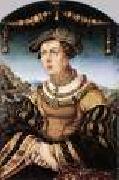 |
WERTINGER, Hans -- Click Here
|
|
German painter (b. 1465, Landshut, d. 1533, Landshut)
German painter and woodcutter. An artist as ambitious as Lucas Cranach I, he became one of Germany's first accredited court painters, working for the Dukes of Landshut in the triangular area defined by Ingolstadt, Straubing and Munich. The son of a functionary working for the Dukes, he was probably first taught by a certain Sigmund Gleism?ller (c. 1449-1511). Hans Mair (Mair von Landshut), who had come from Augsburg and had settled in Landshut, seems to have prompted him to work as a journeyman in Augsburg. His acquisition of citizen's rights in Landshut in 1491 suggests he was a master by that date. Mair seemingly procured him a series of commissions between 1497 and 1499 from Prince Bishop Philipp of Freising (1480-1541). The only work to survive from this period, however, is the large panel of the Life of St Sigismund (1498) in Freising Cathedral. It retains the deep tones associated with Augsburg painting, and its shape, with a pointed arch at the top, must also have been developed in Augsburg. As in Mair's work, several scenes are assembled in the arch and the side sections, creating a cramped Late Gothic framing architecture, |
|
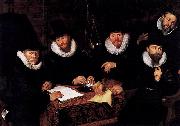 |
Werner van den Valckert -- Click Here
|
|
Though he was born in Amsterdam, he became a member of the Guild of St. Luke in the Hague between 1600 - 1605. By 1614 he had moved to Amsterdam, because his daughter was baptized there. His earliest dated etchings are from 1612. His surviving paintings are historical allegories and portraits. He also made a prestigious schutterstuk, which features the Amsterdam burgermeester Albert Burgh.
According to Houbraken, he was a student of Hendrik Goltzius. He painted a series of 4 paintings showing a doctor as angel, Christ, a man, and the devil; these were all based on engravings by Goltzius. These paintings are now in the possession of the Boerhaave Museum, which has other similar series on display. |
|
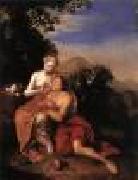 |
WERFF, Pieter van der -- Click Here
|
|
Dutch painter (b. 1665, Kralingen, d. 1722, Rotterdam) |
|
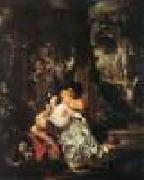 |
WERFF, Adriaen van der -- Click Here
|
|
Dutch Baroque Era Painter, 1659-1722
Dutch painter and draughtsman. He was apprenticed to the portrait painter Cornelis Picolet (1626-79) from 1668 to 1670 and then from c.1671 to 1676 to Eglon van der Neer in Rotterdam. From 1676 van der Werff produced small portraits and genre paintings as an independent master; the Cook and Hunter at a Window (1678; New York, priv. col.; see Gaethgens, no. 2) and Man and Woman Seated at a Table (1678; St Petersburg, Hermitage) perpetuate the thematic and stylistic traditions of Gerrit Dou, Gabriel Metsu, Frans van Mieris and Gerard ter Borch (ii) but are distinguished by their greater elegance and richness of costume and interior. Van der Werff's portraits date mainly from the years 1680-95 (e.g. Two Children with a Guinea-pig and a Kitten (1681; London, Buckingham Pal., Royal Col.)). The motif of children with animals recalls van der Neer, while the careful depiction of fabrics recalls the Leiden school of 'Fine' painters. His Portrait of a Man in a Quilted Gown (1685; London, N.G.) resembles compositions by Caspar Netscher and Nicolaes Maes: a figure leaning against a balustrade, before a landscape. Van der Werff's work is, however, more elegant, in part because of the depiction of fabrics, but also because of the inclusion for the first time of Classical sculpture, in this case the Farnese Flora |
|
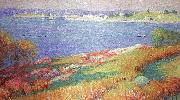 |
Wendel, Theodore -- Click Here
|
|
American, 1859-1932 |
|
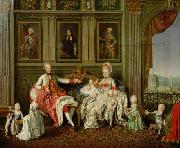 |
Wenceslaus Werlin -- Click Here
|
|
Wenceslaus Werlin (died 1780) was an Austrian painter.
Werlin specialized in portraits. He died in Florence in 1780.
|
|
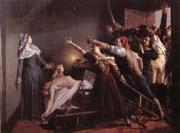 |
Weerts Jean Joseph -- Click Here
|
|
Belgian Academic Painter
1846-Paris 1927
|
|
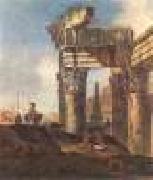 |
WEENIX, Jan Baptist -- Click Here
|
|
Dutch Baroque Era Painter, 1621-ca.1663
Painter and draughtsman, son of Jan Baptist Weenix. Jan probably received his first instruction as a painter from his father, and it is possible that he helped finish certain of his father's works. He probably remained in Utrecht after his father's death. By 1664 he had become a member of the Guild of St Luke in Utrecht without, however, having submitted the required entrance painting, which he provided by 1668. There are several documented references to Jan in the late 1660s. He inherited a legacy along with his uncle, the painter Barent Micker, and other family members in 1667, at which time Gillis, his younger brother, apparently still required a guardian. He received another legacy in 1668, the year of his marriage, and in 1669 served as a witness for the inventory of the painter Jacob de Hennin (1629-c. 1688) in The Hague. |
|
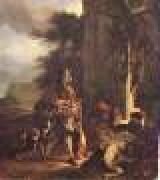 |
WEENIX, Jan -- Click Here
|
|
Dutch painter (b. 1642, Amsterdam, d. 1719, Amsterdam). |
|
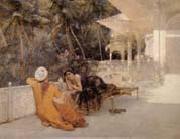 |
Weeks Lord-Edwin -- Click Here
|
|
189-1903
American artist, was born at Boston, Massachusetts, in 1849. He was a pupil of Leon Bonnat and of Jean-Leon Gerome, at Paris. He made many voyages to the East, and was distinguished as a painter of oriental scenes. In 1895 he wrote and illustrated a book of travels, From the Black Sea through Persia and India, and two years later he published Episodes of Mountaineering. He died in November 1903. He was a member of the Legion d'honneur, France, an officer of the Order of St. Michael, Germany, and a member of the Secession, Munich. |
|
|
|
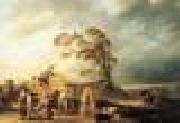 |
WATTEAU, Louis-Joseph -- Click Here
|
|
French Painter, 1731-1798
Nephew of Antoine Watteau. He trained in Paris with Jacques Dumont, and at the Academie Royale, where in 1751 he was awarded first prize for painting. In 1755 he settled in Lille; there he became assistant teacher at the school of drawing, but was dismissed, because of what was considered a scandalous innovation, the introduction of study of the nude, as in Paris. He then returned to Valenciennes for some 15 years; around 1770 he became assistant teacher to Louis-Jean Gueret, director of the school of drawing in Lille, whom he succeeded in the post in 1778. On Watteau's initiative, an annual Salon, at which he himself exhibited regularly, was established in Lille in 1773. |
|
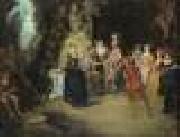 |
WATTEAU, Antoine -- Click Here
|
|
(1684?C1721).
French painter of Flemish descent, b. Valenciennes. Until 1704 poverty forced him to work in the shops of mediocre artists, where he produced genre and devotional subjects. In 1704?C8 he studied in the studio of Claude Gillot, an adept painter of scenes of theatrical life, which later became the subject of some of Watteau's finest paintings, such as Love in the Italian Theatre and Love in the French Theatre (both: Berlin). In 1708?C9 Watteau worked with the decorator Claude Audran. Watteau attracted the attention of eminent patrons in his last years, including the comte de Caylus, his biographer, and in 1717 he was made a full member of the Acad??mie royale. The Embarkation for Cythera (1717; Louvre) is characteristic of his art; it is a delicate, courtly fantasy, represented in warm and shimmering pastel tones that place him among the great colorists of all time. A lyric, Giorgionesque quality pervades his airy, gay, and sensuous scenes, which have a poignancy that none of his followers attained. Out of the most fleeting aspects of life he created an enduring and individual art. His exquisite paintings influenced fashion and garden design in the 18th cent. Other outstanding works include Gilles (Louvre), Perspective (Mus. of Fine Arts, Boston), Mezzetin (Metropolitan Mus.), and Gersaint's Shop Sign (1719; Berlin). |
|
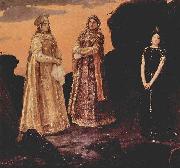 |
Wassnezow, Wiktor Michajlowitsch -- Click Here
|
|
painted Drei Koniginnen des unterirdischen Reiches in 1879 |
|
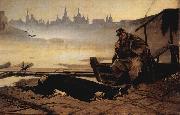 |
Wassilij Grigorjewitsch Perow -- Click Here
|
|
Vasily Grigorevich Perov (Russian; real name Vasily Grigorevich Kridener ; 2 January 1834 (21 December 1833 Old Style) - 10 June (29 May Old Style) 1882) was a Russian painter and one of the founding members of Peredvizhniki, a group of Russian realist painters.
Vasily Perov was born 2 January 1834 (21 December 1833 Old Style) in Tobolsk, being the illegitimate son of procurator, baron Grigory Karlovich Kridener. After completing a course at Arzamas uezd school, he was transferred to the Alexander Stupin art school also located in Arzamas. In 1853 he was admitted to the Moscow School of Painting, Sculpture and Architecture, where he learned from several renowned artists.
In 1856 he was awarded with a minor silver medal for his sketch of a boy's head, presented to the Imperial Academy of Arts. Later the Academy gave him many other awards: in 1857 a major silver medal for Commissary of Rural Police Investigating, a minor golden medal for the Scene on a Grave and the Son of a Dyak Promoted to First Rank, and in 1861 a major golden medal for Sermon in a Village.
After receiving the right to a state-paid trip abroad together with a golden medal, in 1862 Perov went to Western Europe, visiting several German cities, and then Paris. During this time he created paintings depicting scenes from European street life, such as the Vendor of statuettes, the Savoyard, the Organ-Grinder in Paris, the Musicians and the Bystanders, and the Paris Ragpickers.
Returning to Moscow early, from 1865 to 1871 Perov created his masterpieces The Queue at The Fountain, A Meal in the Monastery, Last Journey, Troika, the Lent Monday, Arrival of a New Governess in a Merchant House, the Drawing Teacher, A Scene at the Railroad, the Last Tavern at Town Gate, the Birdcatcher, the Fisherman, and the Hunters at Rest.
|
|
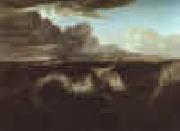 |
Washington Allston -- Click Here
|
|
1779-1843
Washington Allston Gallery Allston was born on a plantation on the Waccamaw River near Georgetown, South Carolina. His mother Rachel Moore had married Captain William Allston in 1775, though her husband died in 1781, shortly after the Battle of Cowpens. Moore remarried to Dr. Henry C. Flagg, the son of a wealthy shipping merchant from Newport, Rhode Island.
Allston graduated from Harvard College in 1800 and moved to Charleston, South Carolina for a short time before sailing to England in May 1801. He was admitted to the Royal Academy in London in September, when painter Benjamin West was then the president.
From 1803 to 1808 he visited the great museums of Paris and then for several years those of Italy, where he met Washington Irving in Rome, and Coleridge, his lifelong friend. In 1809 Allston married Ann Channing, sister of William Ellery Channing. Samuel F. B. Morse was one of Allston's art pupils and accompanied Allston to Europe in 1811. After traveling throughout western Europe, Allston finally settled in London, where he won fame and prizes for his pictures.
Allston was also a published writer. In London in 1813, he published The Sylphs of the Seasons, with Other Poems, republished in Boston, Massachusetts later that year. His wife died in February 1815, leaving him saddened, lonely, and homesick for America.
In 1818 he returned to the United States and lived in Cambridge, Massachusetts for 25 years. He was the uncle of the artists George Whiting Flagg and Jared Bradley Flagg, both of whom studied painting under him.
In 1841 he published Monaldi, a romance illustrating Italian life, and in 1850, a volume of his Lectures on Art, and Poems.
Allston died on July 9, 1843, at age 64. Allston is buried in Harvard Square, in "the Old Burying Ground" between the First Parish Church and Christ Church. |
|
|
|
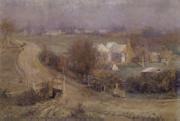 |
Walter Withers -- Click Here
|
|
English-born Australian Painter,
1854-1914
was an Australian landscape artist and a member of the Heidelberg School of Australian impressionists. Withers was born at Handsworth, Staffordshire, the son of Edwin Withers. He showed an early desire to paint, but objection was made to this by his father. It is not known what occupation he followed in England, but in 1882 he arrived in Australia with the intention of going on the land. After working for about 18 months on a farm, Withers removed to Melbourne and obtained a position as draughtsman in a firm of printers. He then took up his painting again, and began to exhibit with the Victorian Academy of Arts afterwards merged in the Victorian Artists' Society. In 1887 Withers went to Europe. There he was married to Miss F. Flinn and studied for some months at the Academie Julian, Paris. He returned to Australia with his wife in June 1888 having been commissioned to do black and white work for Messrs Fergusson and Mitchell of Melbourne. His most important work in this way will be found in the illustrations to Edmund Finn's, The Chronicles of Early Melbourne. Withers settled down at first at Kew, a suburb of Melbourne, and then near Heidelberg on the other side of the river Yarra. He became friendly with Arthur Streeton, Charles Conder, Tom Roberts, Frederick McCubbin and other leading artists of the period. He began to sell a few pictures, but the collapse of the land boom put an end to his illustrative work. He obtained some work as a drawing and painting master in schools, and in 1891 opened a studio in Collins-street west, where he held his first private exhibition. |
|
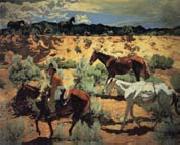 |
Walter Ufer -- Click Here
|
|
American Painter, 1876-1936,was an American artist based in Taos, New Mexico. His most notable work focuses on scenes of Native American life, particularly of the Pueblo Indians. Walter was born of German immigrant parents and raised in Kentucky. After an apprenticeship as a lithographer, he went to Europe where he was a traveling journeyman. When he returned to America, he worked as a printer in Chicago and taught school, and later took classes in fine arts. After a brief time in Chicago, he returned to Europe for further study as an artist. |
|
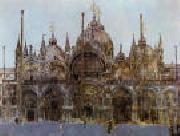 |
Walter Sickert -- Click Here
|
|
German
1860-1942
Walter Sickert Gallery
Walter Richard Sickert (May 31, 1860 in Munich, Germany ?C January 22, 1942 in Bath, England) was a German-born English Impressionist painter. Sickert was a cosmopolitan and eccentric who favoured ordinary people and urban scenes as his subjects
He developed a personal version of Impressionism, favouring sombre colouration. Following Degas' advice, Sickert painted in the studio, working from drawings and memory as an escape from "the tyranny of nature".[3] Sickert's earliest major works were portrayals of scenes in London music halls, often depicted from complex and ambiguous points of view, so that the spatial relationship between the audience, performer and orchestra becomes confused, as figures gesture into space and others are reflected in mirrors. The isolated rhetorical gestures of singers and actors seem to reach out to no-one in particular, and audience members are portrayed stretching and peering to see things that lie beyond the visible space. This theme of confused or failed communication between people appears frequently in his art.
By emphasising the patterns of wallpaper and architectural decorations, Sickert created abstract decorative arabesques and flattened the three-dimensional space. His music hall pictures, like Degas' paintings of dancers and caf??-concert entertainers, connect the artificiality of art itself to the conventions of theatrical performance and painted backdrops. Many of these works were exhibited at the New English Art Club, a group of French-influenced realist artists with which Sickert was associated. At this period Sickert spent much of his time in France, especially in Dieppe where his mistress, and possibly his illegitimate son, lived |
|
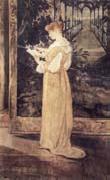 |
Walter Shirlaw -- Click Here
|
|
Scottish-American artist , 1838-1909
was a Scottish-American artist. Shirlaw was born in Paisley, Scotland, and moved to the United States with his parents in 1840. He worked as a bank-note engraver, and his work was first exhibited at the National Academy in 1861. He was elected an academician of the Chicago Academy of Design in 1868. Among his pupils there was Frederick Stuart Church. From 1870 to 1877 he studied in Munich, under George Raab, Richard Wagner, Arthur George von Ramberg, and Wilhelm Lindenschmidt. His first work of importance was the Toning of the Bell (1874), which was followed by Sheep-shearing in the Bavarian Highlands (1876). The latter, which is probably the best of his works, received honorable mention at the Paris exposition in 1878. Other notable works from his easel are Good Morning (1878), in the Buffalo Academy; Indian Girl and Very Old (1880); Gossip (1884); and Jealousy (1886), owned by the Academy of Design, New York. His largest work is the frieze for the dining-room in the house of Darius O. Mills in New York. Shirlaw has also earned an excellent reputation as an illustrator. He was one of the founders of the Society of American Artists, and was its first president. On his return from Europe he took charge of the Art Students League of New York, and for several years taught in the composition class. |
|
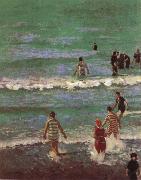 |
Walter Richard Sickert -- Click Here
|
|
British Camden Town Group Painter, 1860-1942
British painter, printmaker, teacher and writer of German birth. Sickert was one of the most influential British artists of this century. He is often called a painter painter, appealing primarily to artists working in the figurative tradition; there are few British figurative painters of the 20th century whose development can be adequately discussed without reference to Sickert subject-matter or innovative techniques. He had a direct influence on the Camden Town Group and the Euston Road School, while his effect on Frank Auerbach, Howard Hodgkin and Francis Bacon was less tangible. Sickert active career as an artist lasted for nearly 60 years. His output was vast. He may be judged equally as the last of the Victorian painters and as a major precursor of significant international developments in later 20th-century art, especially in his photo-based paintings. |
|
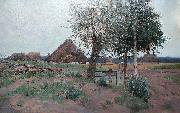 |
Walter Moras -- Click Here
|
|
painted Markisches Dorf in 1888 |
|
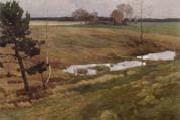 |
Walter Leistikow -- Click Here
|
|
1865-1908,German painter, decorative artist, etcher, exhibition organizer and writer. He studied painting briefly in 1883, at the Akademie in Berlin, but he was dismissed after six months as 'untalented'. From 1883 to 1885 he trained with the painter Hermann Eschke (1823-1900) and from 1885 to 1887 with the Norwegian painter Hans Fredrik Gude. Gude had a decisive influence on the style of Leistikow's early works, as is especially clear in Leistikow's light coastal landscapes with figures. His most significant work from this period, however, is Brickworks near Eckernferde (1887; ex-Gem?ldegal. Neue Meister, Dresden). Leistikow's dismissal from the Akademie concentrated his attention on issues of artistic policy. When the German government decided not to send works for exhibition in the Exposition Universelle in Paris in 1889, Leistikow himself organized the dispatch of works to Paris. In 1892, |
|
|
|
|
|
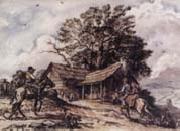 |
Walter Jack Duncan -- Click Here
|
|
He was born in Indianapolis, Indiana .
American, 1881-1941 |
|
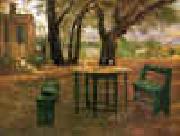 |
Walter I Cox -- Click Here
|
1866-1930
English
Can you freeze blue apron meals
Are you a busy parent or an overwhelmed office worker who just doesn??t have the time for cooking? You know what it feels like to be tired and famished but lack the energy to cook, right? If so, then Blue Apron meals might just sound like a lifesaver! Though they provide scrumptious home-cooked meals in minutes, do you ever find yourself with more meal options than you can eat that week? Well have we got good news for you - yes, indeed you *can* freeze Blue Apron Meals! Keep reading to find out exactly how.
Exploring freezing blue apron meals - what recipes can you freeze, and for how long
Exploring freezing Blue Apron meals can be a fun and flavorful way to enjoy later in the month. Whether you've just received your delivery or need to preserve leftovers, most of Blue Apron's recipes can be frozen for up to three months. Many seafood dishes, such as recipes involving white fish, salmon and shellfish, do not freeze well and should be consumed within 1-2 days. Other dishes, such as stir-fries, braises, stews, soups and pastas lend themselves particularly well for freezing. When making these dishes at home from a Blue Apron kit or Hellofresh kit hellofreshvsblueapron, simply portion out individual servings in airtight containers before freezing. Once you're ready to reheat the meal again, simply place the container back in the fridge overnight before cooking!
How to choose the best meals from blue apron to freeze
Freezing meals from Blue Apron is a great way to make sure you're always prepared for mealtimes. Depending on your tastes and preferences, there are a few tips and tricks you should bear in mind when selecting meals to freeze. Firstly, if you're aiming for the best possible quality upon defrosting, look for recipes with minimal dairy content. Dairy does not survive freezing well and can lead to a gritty texture after thawing. Secondly, consider recipes containing more neutral ingredients like vegetables or fish, as these will retain their flavors better than more robust options such as steak or pork chops. Lastly, be mindful of highly-seasoned ingredients as these tend to lose flavor faster than basic ones when frozen. Doing these things will ensure that by taking the time to freeze a meal now, you'll be able to enjoy it later at its peak flavor level!
Tips for prepping and packaging blue apron meals before freezing them
Prepping and packaging blue apron meals before freezing them is a simple but effective way to save time when cooking during the week. For best results, it??s important to properly season the un-prepped pre-measured ingredients prior to combining them. This will make sure that the flavors of the meal are properly distributed. Once seasoned, combine the ingredients in one large bowl or dish, this will make packaging easier and result in less waste. Transferring prepped meals into storage bags or containers should be done quickly in order to properly seal out air, this will keep your meal fresher for longer. Finally, don??t forget to label each bag with the name of dish and date you prepped it. Following these simple tips for prepping and packaging blue apron meals before freezing them will ensure you have delicious home cooked meals ready throughout the week without spending hours putting dishes together from scratch!
What effects does freezing have on the nutritional content of blue apron meals
Flash freezing is incredibly beneficial to blue apron meals as it preserves the nutritional content of the food. When produce is picked off the vine, nutrient levels are at their peak and will decay over time. Thankfully, flash freezing locks in the flavor and nutrition contained in blue apron??s fresh ingredients so that you can be sure you are enjoying healthy, delicious meals. This method also significantly decreases spoilage so that your food won??t go bad nearly as quickly, allowing for fewer trips to the grocery store and more time spent enjoying your meals with friends and family.
|
|
|
|
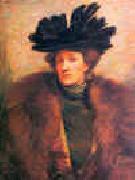 |
Walter Griffin -- Click Here
|
|
1861-1935
Walter Burley Griffin November 24, 1876?CFebruary 11, 1937) was a US architect and landscape architect, who is best known for his role in designing Canberra, Australia's capital city. He has also been credited with the development of the L-shaped floor plan, the carport and the first use of reinforced concrete.
Influenced by the Chicago-based Prairie School, Griffin went on to develop a unique modern style. For much of his career Griffin worked in partnership with his wife Marion Mahony Griffin. In the 28 years of their architectural partnership, the Griffins designed over 350 building, landscape and urban-design projects as well as designing construction materials, interiors, furniture and other household items. |
|
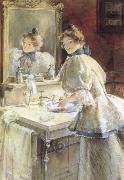 |
Walter Granville Smith -- Click Here
|
|
Illustrator and Painter
American
1870-1938
|
|
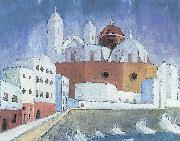 |
Walter Gramatte -- Click Here
|
|
Walter Gramatte (8 January 1897 in Berlin - 9 February 1929 in Hamburg) was a German expressionist painter who specialized in magic realism. He often painted with a mystical view of nature.
Walter Gramatte died on 9 February 1929 of Intestinal Tuberculosis.
His second wife Sonia married again, was then named Sophie Carmen Eckhardt-Gramatte and lived in Canada as a renowned musician. To remember her and her former husband Walter Gramatte „The Eckhardt-Gramatte-Foundatione was established in Winnipeg, Canada.
Walter Gramatte's written posthumous works are preserved in the German National Museum.
A special exhibition of his paintings, titled Rediscovered: Walter Gramatte 1897-1929, took place in Hamburg Ernst Barlach Haus from October 26, 2008 to February 1, 2009. This exhibition was organized by Kirchner Museum in Davos, Switzerland and the Ernst Barlach Haus in Hamburg, Germany.
|
|
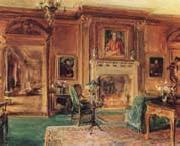 |
Walter Gay -- Click Here
|
|
1856-1937. He was an American painter born at Hingham, Massachusetts. He married heiress Matilda E. Travers, the daughter of prominent New York City investor and co-founder of Saratoga Race Course, William R. Travers. In 1876 the couple moved to Paris, France where Walter Gay became a pupil of Leon Bonnat. They lived in an apartment on the Left Bank and in 1907 purchased Chateau Le Breau on a three-hundred-acre walled park near the Forest of Fontainebleau. Walter Gay received an honorable mention in the Paris Salon of 1885; a gold medal in 1888, and similar awards at Vienna (1894), Antwerp (1895), Berlin (1896) and Munich (1897). He became an Officer of the Legion of Honor and a member of the Society of Secession, Munich. |
|
|
|
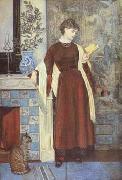 |
Walter Crane,RWS -- Click Here
|
|
1845-1915
English painter, illustrator, designer, writer and teacher. He showed artistic inclinations as a boy and was encouraged to draw by his father, the portrait painter and miniaturist Thomas Crane (1808-59). A series of illustrations to Tennyson's The Lady of Shalott (Cambridge, MA, Harvard U., Houghton Lib.) was shown first to Ruskin, who praised the use of colour, and then to the engraver William James Linton, to whom Crane was apprenticed in 1859. From 1859 to 1862 Crane learnt a technique of exact and economical draughtsmanship on woodblocks. His early illustrative works included vignette wood-engravings for John R. Capel Wise's The New Forest: Its History and its Scenery (1862). |
|
 |
Walter Crane -- Click Here
|
|
English Golden Age Illustrator, 1845-1915
English painter, illustrator, designer, writer and teacher. He showed artistic inclinations as a boy and was encouraged to draw by his father, the portrait painter and miniaturist Thomas Crane (1808-59). A series of illustrations to Tennyson's The Lady of Shalott (Cambridge, MA, Harvard U., Houghton Lib.) was shown first to Ruskin, who praised the use of colour, and then to the engraver William James Linton, to whom Crane was apprenticed in 1859. From 1859 to 1862 Crane learnt a technique of exact and economical draughtsmanship on woodblocks. |
|
|
|
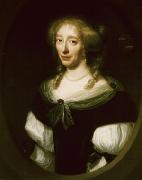 |
Wallerant Vaillant -- Click Here
|
|
Wallerant Vaillant, (Lille 30 May 1623 - Amsterdam 28 August 1677), was a painter of the Dutch Golden Age and one of the first artists to use the mezzotint technique, which he probably helped to develop.
Wallerant Vaillant was the oldest of five brothers, who all became successful painters.
Jacques (1625 - 1691) traveled to Italy where he joined the Bentvueghels in Rome with the nickname Leeuwrik, and settled later in Berlin.
Jan (1627 - 1668+) was an engraver considered to be a member of the school of Frankenthal and later became a merchant in Frankfurt.
Bernard (1632 - 1698) accompanied Wallerant on all of his travels, and settled later in Rotterdam, where he became deacon of the Wallonian Church.
Andreas (1655 - 1693), the youngest, became an engraver in Paris, and died in Berlin visiting his brother Jacques.
It is said Wallerant was a student of Erasmus Quellinus II (1607 - 1678) in Antwerp. He moved with his parents in 1643 to Amsterdam. In 1647 he lived in Middelburg, but in 1649 he was back in Amsterdam. In 1658 he traveled with his brother to Frankfurt and Heidelberg. He helped invent the Mezzotint technique (schraapkunst, or zwartekunst) with Prince Rupert of the Rhine when he was his tutor performing experiments in etching techniques. In 1659 he went to Paris with Philibert de Gramont where he stayed five years.
|
|
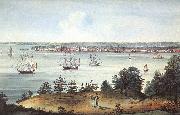 |
Wall, William Guy -- Click Here
|
|
American, 1792-1862 |
|
|
|
|
|
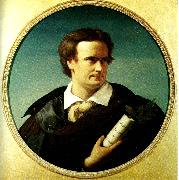 |
w. von schadow -- Click Here
|
|
Friedrich Wilhelm Schadow (7 September 1789 - 19 March 1862) was a German Romantic painter.
He was born in Berlin and was the second son of the sculptor Johann Gottfried Schadow.
In 1806-1807 Friedrich served as a soldier. In 1810 he traveled with his elder brother Rudolph to Rome where he became one of the leaders among painters of the Nazarene movement. Following the example of Johann Friedrich Overbeck and others, he joined the Roman Catholic Church, and held that an artist must believe and live out the truths he essays to paint. The sequel showed that Schadow was qualified to shine more as a teacher and mentor than as a painter. As an author, he is best known for his lecture, Ueber den Einfluss des Christentums auf die bildende Kunst (About The Influence of Christianity On The Visual Arts) (Dusseldorf, 1843), and the biographical sketches, Der moderne Vasari (Berlin, 1854).
In Rome, Schadow was given one of his first major commissions when the Prussian Consul-General, General Jakob Salomon Bartholdy, befriended the young painter, and asked him and three young compatriots (Cornelius, Overbeck and Veit) to decorate in fresco a room in his house on the Pincian Hill. The overall theme selected was the story of Joseph and his brethren, and two scenes, the Bloody Coat and Joseph in Prison, were conferred on Schadow. In 1819, Schadow was appointed professor in the prestigious Berlin Academy of the Arts, and his ability and thorough training gained many devoted disciples.
It was during this period that Schadow developed his paintings for churches. In 1826, Professor Schadow was made director of the Dusseldorf Academy of the Arts, which he reoriented towards the production of Christian art, though he began a major dispute with one of its professors, Heinrich Christoph Kolbe, ending in the latter leaving the Academy in 1832. In 1837, Schadow selected, at request, those of his students best qualified to decorate the chapel of St Apollinaris on the Rhine with frescoes. When finished, they were acclaimed as the fullest and purest manifestation of the spiritual side of the D??sseldorf school. One of his famous students, Heinrich Mucke, carried on the liturgical art with emphasis both in painting and frescoes. The painting of the Wise and Foolish Virgins. considered one of his masterworks, was commissioned in 1842. Now in the Städel Museum, this large and important picture, while carefully considered and rendered, it however lacks power of some of his other works.
Schadow's fame rests less on his own artistic creations than on the school he formed. In D??sseldorf a reaction set in against the spiritual and sacerdotal style he had established and, in 1859, the party of naturalism, after a severe struggle, drove Director Schadow from his chair. Friedrich Wilhelm Schadow died at Dusseldorf in 1862, and a monument was erected in the square which bears his name at a jubilee held to commemorate his directorate.
The D??sseldorf School that Schadow directed became internationally renowned, attracting such American painters as George Caleb Bingham, Eastman Johnson, Worthington Whittredge, Richard Caton Woodville, William Stanley Haseltine, James M. Hart, and William Morris Hunt and producing the German emigre Emmanuel Leutze. |
|
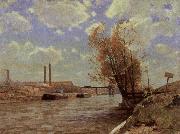 |
Victor Westerholm -- Click Here
|
|
Finnish, 1860-1919
Finnish painter. He studied at the School of Drawing in Turku from 1869 to 1878. In 1878 he travelled to Dosseldorf and enrolled at the Kunstakademie, where he attended classes on landscape painting by Eugen Docker until 1886. He spent his summers in Finland, on the aland Islands, preparing sketches that provided the groundwork for many of the paintings he produced in Dosseldorf. Although Westerholm began working according to the principles of studio painting, his vivid studies are often imbued with the crispness of the plein-air style. In the early 1880s he concentrated on painting autumnal scenes and rapidly became the leading landscape artist of the younger generation with such works as the Mail-packet Jetty at Ecker (1885; Hemeenlinna, A. Mus.). |
|
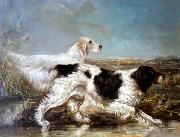 |
Verner Moore White -- Click Here
|
|
Verner Moore White (October 5, 1863 - August 30, 1923), born Thomas Verner Moore White but informally known as Verner White, was an American landscape and portrait painter. White painted works for many of the business and political leaders of his time including commissions for three United States Presidents.
|
|
 |
VELDE, Willem van de, the Younger -- Click Here
|
|
Dutch painter (b. 1633, Leiden, d. 1707, London).
was a Dutch marine painter. Willem van de Velde was baptised on 18 December 1633 in Leiden, Holland, Dutch Republic. A son of Willem van de Velde the Elder, also a painter of sea-pieces, Willem van de Velde, the younger, was instructed by his father, and afterwards by Simon de Vlieger, a marine painter of repute at the time, and had achieved great celebrity by his art before he came to London. In 1673 he moved to England, where he was engaged by Charles II, at a salary of £100, to aid his father in "taking and making draughts of sea-fights", his part of the work being to reproduce in color the drawings of the elder van de Velde. He was also patronized by the Duke of York and by various members of the nobility. He died on 6 April 1707 in London, England. Most of Van de Velde's finest works represent views off the coast of Holland, with Dutch shipping. His best productions are delicate, spirited and finished in handling, and correct in the drawing of the vessels and their rigging. The numerous figures are tellingly introduced, and the artist is successful in his renderings of sea, whether in calm or storm. |
|
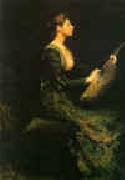 |
Thomas Wilmer Dewing -- Click Here
|
|
1851-1938
Thomas Wilmer Dewing Gallery
was an American painter working at the turn of the 20th century. He was born in Newton Lower Falls, Massachusetts. He studied at the Acad??mie Julian in Paris, and later settled into a studio in New York City. He married Maria Oakey Dewing, an accomplished painter with extensive formal art training and familial links with the art world.
He is best known for his tonalist paintings, a sub-genre of American art that was rooted in English Aestheticism. Dewing's preferred vehicle of artistic expression is the female figure. Often seated playing instruments, writing letters, or engaged in other impassive actions and situated in gauzy, dreamy interiors, the figures remain remote and distant to the viewer. These scenes are infused with a color that pervades the entire picture, setting tone and mood. The ethereal delicacy and subtle color harmonies of Dewing's paintings have not met with universal approval: some feminist critics have lambasted Dewing's work as being misogynistic; he rarely painted anything other than the female figure, vacant of expression, languishing in sumptuous clothing.
Tonalism quickly came to be considered outdated with the advent of modernism and abstraction in art, though Dewing was successful in his own day. His art was considered extremely elegant, and has undergone a subtle revival in the last 10 years or so.
Dewing was a member of the Ten American Painters, a group of American Impressionists who seceded from the Society of American Artists in 1897.
He spent his summers at the art colony in Cornish, New Hampshire. |
|
|
|
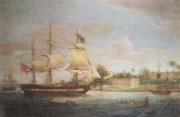 |
Thomas Whitcombe -- Click Here
|
|
British
1760-1824
British 1760-1824 was a British maritime painter Thomas Whitcombe was born in London between 1752 and 19 May 1763, with the latter date frequently cited. Little is known of his background or training, although speculation based on the locations depicted in his paintings may provide some clues. It is known that he was in Bristol in 1787 and later travelled to the South Coast; there are few ports or harbours from this region that do not feature in his work. In 1789 he toured Wales and in 1813 he travelled to Devon, painting scenes around Plymouth harbour. During his career he also painted scenes showing the Cape of Good Hope, Madeira, Cuba and Cape Horn. Between 1783 and 1824 he lived in London. His date of death, like that of his birth is uncertain; it was not before 1824, and possibly as late as 1834. |
|
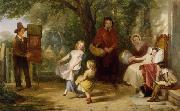 |
Thomas Webster -- Click Here
|
|
(March 10, 1800 - September 23, 1886), was an English genre painter, who lived for many years at the artists' colony in Cranbrook.
Webster was born in Ranelagh Street, Pimlico, London. His father was a member of the household of George III, and the son, having shown an aptitude for music, became a chorister, first at St George's Chapel in Windsor Castle, then the Chapel Royal at St. James's Palace in London. He abandoned music for painting, however, and in 1821 was admitted as a student to the Royal Academy, exhibiting, in 1824, portraits of "Mrs Robinson and Family." In the following year he won first prize in the school of painting.
In Sickness and Health (1843)In 1825, also, Webster exhibited 'Rebels shooting a Prisoner,' at the Suffolk Street Gallery - the first of a series of pictures of schoolboy life for which he subsequently became known - . In 1828 he exhibited 'The gunpowder Plot' at the Royal Academy, and in 1829 'The Prisoner' and 'A Foraging Party aroused' at the British Institution. These were followed by numerous other pictures of school and village life at both galleries. In 1840 Webster was elected an associate of the Royal Academy (ARA), and in 1846 a Royal Academician (RA) academician. He continued to be a frequent exhibitor till 1876, when he retired from the academy. He exhibited his own portrait in 1878, and 'Released from School,' his last picture, in 1879.
In 1856 Webster was photographed at 'The Photographic Institute', London, by Robert Howlett, as part of a series of portraits of 'fine artists'. The picture was among a group exhibited at the Art Treasures Exhibition in Manchester in 1857.
From 1835 to 1856 Webster resided at The Mall, Kensington, but the last thirty years of his life were spent at the artists' colony in Cranbrook, Kent, where he died on 23 Sept. 1886.
|
|
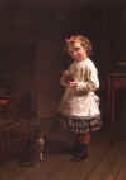 |
Thomas Waterman Wood -- Click Here
|
|
1823-1903
It may be that his reputation as an artist will rest upon his figure pictures, although his very numerous portrait paintings involved much of the effort of his life and are most certainly characterized but simple and strong composition, great technical execution and a masterful use of colors. It may also follow that he will yet achieve his most memorable honors from the interpretations which he has made of great paintings, but from the stand point of those whose minds and hearts are won by considerations of local history the highest interest will be assigned to works in which Wood included characters from his native place. As examples of his work in this direction the following may be mentioned: The Yankee Pedlar had for its model a tin peddler known as "Snapping Tucker", a resident of Calais, Vermont. When this work was sold for a large sum, Tucker promptly claimed his share upon the grounds of his intrinsic worth and natural capacity as a poser. The Village Post Office was taken from the interior of the old Ainsworth store in Williamstown, Vermont, but the figures were mostly taken from Montpelier people. Wood's uncle Zenas was the postmaster and the group around the store, Boyden, Whittier and Bullock, were old-time residents. Their clerk was Horace Scribner, long esteemed as a generous country musician and as the organist of Christ Church. This painting was bought by Mr. Charles Stewart Smith, ex-president of the New York Chamber of Commerce. The scene for the The Quack Doctor was located in front of the old arch which once spanned the head of State Street leading to East State. The old brick building, the home of Montpelier Book Bindery, still stands. This picture was bought by Mr. George I. Seneg for $2,000 and after his death was included in the sale of his entire collection.
Another successful painting was The Country Doctor. The artist found the proper model for this work with the aid of the Secretary of State, Dr. George Nichols, in the person of an actual country doctor, then representing the town of Jamaica in the legislature. This doctor bore upon his face the impress of his beneficent labors for more than 40 years in a back country town. Wood himself told the writer, in speaking of this painting, that many a person had said to him, "That doctor is the exact image of my father, who was also a country doctor." This saying he regarded not so much as proof that he had achieved a concrete likeness but as an evidence of having successfully handed down the particular class idea of the old-fashioned country physician, as truly different in type from the city practitioner as was the country lawyer of former days from his brother in the city.
In 1891, Wood exhibited at the Academy a picture entitled A Cogitation, for which one of his Montpelier friends, Mr. George Ripley, posed. The composition is extremely simple, a farmer in his barn, leaning upon his pitchfork, his countenance thoughtful. This picture was bought by Mr. Harper and published as a full-page engraving in Harper's Weekly during the Greeley campaign over the title "Is Greeley a Fool or a Knave?". The humorous side of this incident consists in the fact that Mr. Ripley was the model was an ardent supporter of Mr. Greeley in that campaign, while the artist himself, so far as we know, never dabbled in politics.
These few examples sufficiently illustrate the influence which the place of his birth had upon Wood. He was not only a Vermonter but a great painter of Vermont ideas, conditions and character. Nor did foreign travel nor city residence nor any influence of professional connections ever tend to diminish the deep and abiding interest in his early home. The subjects of his works, his selection of characters, his yearly pilgrimage to Vermont, all demonstrate his filial loyalty and he gave to this sentiment of his heart its final expression in the establishment, as a gift to Montpelier, of its Gallery of Art. But, apart from this, the homes, offices and institutions of Montpelier and without are filled with the affectionate and great evidences of his work. The Vermont Historical Society possesses several excellent examples of his portraiture, all of great historic value and preserved in the Cedar Creek Reception Room at the Vermont State House: Samuel Prentiss (1881), United States Senator; Mrs. Samuel Prentiss (1895) and Dr. Edward Lamb (1895), gifts to the Society by the family of Mr. Prentiss. In 1896, the Society unveiled a life-size portrait of the distinguished publicist, the Hon. E. P. Walton, the gift of his wife and sister. Wood's personal donations include portraits of the Rev. William A. Lord, D.D. (1874), minister of Bethany Congregational Church of this city, Daniel Pierce Thompson (1880), novelist and author of "The Green Mountain Boys", and Justin S. Morrill, United States Senator, father of tariff legislation, promoter of agricultural colleges and chief up builder of the Library of Congress.
One of the noblest paintings now existing in the state is the artist's beautiful translation of Bartolom?? Esteban Murillo's "La Madonna del Rosario". This work, submitting the original with infinite tenderness and feeling, was painted in 1896 in the Dulwich Gallery and was consecrated by Bishop de Goesbriand for the service of Saint Augustine's Church on July 26, 1897. The essential force of this sacred painting is its actual power to impress the beholder with a profound sense of the sacredness of motherhood and the worth and lasting values of purity and religious faith. In accepting this donation from Wood the Reverend Bishop said: "You have made a great Murillo of the seventeenth century our contemporary," an expression not only true of itself but one which defines the special value of the truly great copies of great paintings. |
|
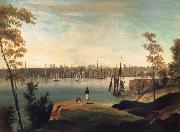 |
Thomas Kelah Wharton -- Click Here
|
|
British/American, 1814-1862 |
|
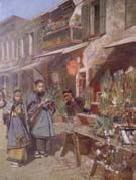 |
Theodore Wores -- Click Here
|
|
American Painter, ca.1859-1939,was an American painter born in San Francisco. Wores began his art training at age twelve in the studio of Joseph Harrington, who taught him color, composition, drawing and perspective. When the San Francisco School of Design opened in 1874, Wores was one of the first pupils to enroll. After one year at that school under the landscape painter Virgil Macey Williams, he continued his art education at the Royal Academy in Munich where he spent six years. He also painted with William Merritt Chase and Frank Duveneck. Wores returned to San Francisco in 1881. He went to Japan for two extended visits and had successful exhibitions of his Japanese paintings in New York and London, where he became friends with James Abbott McNeill Whistler and Oscar Wilde. He visited Hawaii and Samoa in 1901-1902 and established a home in San Francisco about 1906. He visited Hawaii for a second time in 1910?C1911. For the remainder of his career, Wores painted the coast on the western edge of San Francisco. He died in San Francisco in 1939. His most famous work is The Lei Maker, which is on permanent display at the Honolulu Academy of Arts. |
|
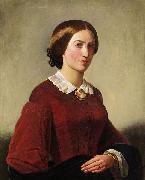 |
Theodor Leopold Weller -- Click Here
|
|
Germany (1802 -1880 ) - Drawer
painted Portrat einer Dame mit Brosche in19th century
|
|
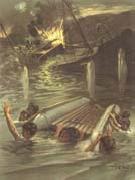 |
T.Dart Walker -- Click Here
|
|
Illustrator and marine artist
American ,1869-1914
|
|
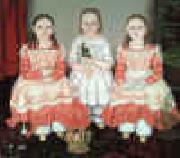 |
Susan C Waters -- Click Here
|
|
1823-1900
Susan C Waters Gallery |
|
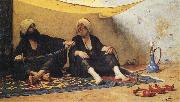 |
Stephen Wilson Van Schaick -- Click Here
|
|
American, 1848 - 1920 |
|
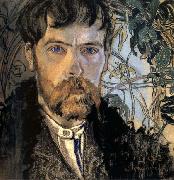 |
Stanislaw Wyspianski -- Click Here
|
|
1869-1907
was a Polish playwright, painter and poet, as well as interior and furniture designer. A patriotic writer, he created a series of symbolic, national dramas within the artistic philosophy of the Young Poland Movement. Wyspiaeski was one of the most outstanding and multifaceted artists of his time in Europe. He successfully joined the trends of modernism with themes of the Polish folk tradition and Romantic history. Unofficially, he came to be known as the Fourth Polish Bard. Stanisław Wyspiaeski was born to Franciszek Wyspiaeski and Maria Rogowska. His father, a sculptor, owned an atelier on Wawel Hill. His mother died of tuberculosis in 1876 when Stanisław was seven years old. Due to alcohol problem, Stanisław's father could not fulfil his parental responsibilities. Stanisław was adopted by his aunt Joanna Stankiewiczowa and her husband Kazimierz. The Stankiewicz family belonged to a bourgeois and intellectual class. In their house Wyspiaeski became acquainted with painter Jan Matejko, who was a frequent visitor. Matejko soon recognized that the boy had artistic talent and gave him the first artistic guidance. Wyspiaeski attended Saint Anne's Secondary. The school was unique for several reasons. Firstly, although Polish language was forbidden in educational institutions under foreign rule, the lectures in Saint Anne's Gymnasium were delivered in Polish. Secondly, the teacher's goal was to equip the students with a thorough knowledge of Polish history and literature. Thirdly, the school graduates, which included Lucjan Rydel, Stanisław Estreicher and Henryk Opieeski, were considered prominent figures in Krakew's cultural life. As a student Wyspiaeski did not display any specific talent, but took particular interest in art and literature. According to Joanna Stankiewiczowa, a young Stanisław portrayed small village cottages, animals, plants, armors and decorations. As far as literature was concerned, Wyspiaeski created a dramatic interpretation of Matejko's painting Stefan Batory pod Pskowem (Bathory at Pskov). In 1887 Wyspiaeski enrolled in the Philosophy Department at the Jagiellonian University and the School of Fine Arts in Krakew. While studying at the University, he attended lectures in art, history and literature. Jan Matejko, the dean of the School of Fine Arts soon recognized Wyspiaeski's talent and asked him to join in the creation of a polychrome inside the Mariacki Church. The years 1890-1895 were devoted to traveling. Wyspiaeski visited Italy, Switzerland, Germany, Prague and France. The stay in France was regarded to be the major point in his artistic life. He studied at the private atelier Academie Colarossi. Since the school fee was very high, Wyspiaeski applied for a grant. During the stay in France he got acquainted with Paul Gauguin. Together they visited art museums, where Wyspiaeski was bewitched by the beauty of Pierre Puvis de Chavannes's paintings. He also attended theatre performances based on Shakespeare's and antic plays. His future dramas: Daniel i Meleager (Daniel and Meleagra) and Powret Odysa (Return of Odysseus) were based on the antic tradition. Meanwhile, he worked on several dramas Krelowa Polskiej Korony (The Queen of Polish Crown), Warszawianka (Varsovian Anthem) and the first version of Legenda (Legend). The play Legenda (Legend) was based on the famous Polish legend about Wars and Sawa. In August 1894 he returned to Krakew, where he got involved in the modernist movement. It was then he designed and partially made a polychrome for the Franciscan Church that was composed of flowery, geometrical and heraldic motifs. Moreover, the prior of the church encouraged Wyspiaeski to design various stained glass windows such as Blessed Salomea, Saint Francis Stigmata and God the Father. It is worth mentioning that Wyspiaeski received an award of the Polish Academy of Learning for the landscape of the Kopiec Kościuszki (Kościuszko Mound). |
|
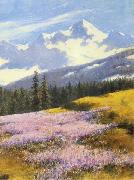 |
Stanislaw Witkiewicz -- Click Here
|
|
(8 May 1851 in Pašiaušė - 5 September 1915 in Lovran) was a Polish painter, architect, writer and art theoretician.
Witkiewicz was born in the Lithuanian village of Pašiaušė (Polish: Poszawsze) in Samogitia, at that time, in the partitioned Polish-Lithuanian Commonwealth lands ruled by the Russian Empire.
Witkiewicz studied in Saint Petersburg, 1869-71, then in Munich, 1872-75.
He created the Zakopane Style (styl zakopiaki) (also known as Witkiewicz Style (styl witkiewiczowski)) in architecture. He was strongly associated with Zakopane and promoted it in the art community.
His son, Stanisław Ignacy Witkiewicz, became a famous painter, playwright, novelist and philosopher, also known (from the conflation of his surname and middle name) by the mononymous pseudonym "Witkacy." The son's godmother was the internationally famous actress Helena Modjeska (Helena Modrzejewska), whom the elder Witkiewicz in 1876 had nearly accompanied to California in the United States.
Witkiewicz had strong views against formal education: "school is completely at odds with the psychological make-up of human beings". He applied this principle in his son's upbringing and was disappointed when the 20-year-old Witkacy chose to enroll at the Academy of Fine Arts in Krakew.
In 1908, suffering from tuberculosis, the elder Witkiewicz left his family in Zakopane and relocated to Lovranno, a fashionable resort in what was then Austria-Hungary, which today is in Croatia. He died there in 1915.
|
|
 |
Stanislaw Ignacy Witkiewicz -- Click Here
|
|
Polish Painter, 1885-1939
.Polish writer, art theorist, painter and photographer. He was the son of the architect, painter and critic Stanislaw Witkiewicz (1851-1915), creator of the 'Zakopane style' |
|
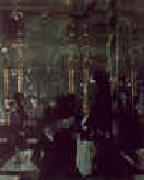 |
Sir William Orpen -- Click Here
|
|
Irish
1878-1931
Sir William Orpen Location
Irish painter. He attended the Metropolitan School of Art, Dublin (1891-7), and the Slade School of Art, London (1897-9), there winning the composition prize of 1899 with The Play Scene from Hamlet (Houghton Hall, Norfolk). He became a friend of Augustus John and joined the New English Art Club. From very early years he had been an impassioned student of the Old Masters, and he went to Paris with John in 1899 to see Leonardo da Vinci Mona Lisa (Paris, Louvre). In the following years his perception of their works |
|
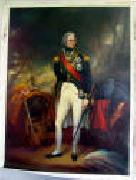 |
Sir William Beechey -- Click Here
|
|
1753-1839
British
English painter. He was trained as a lawyer before entering the Royal Academy Schools, London, in 1772. He is thought to have studied under Johan Zoffany, and his earliest surviving portraits are small-scale full-lengths and conversation pieces in Zoffanys manner (e.g. The Custance Conversation Piece, c. 1786; priv. col.). Beechey first exhibited at the Royal Academy in 1776. In 1782 he moved to Norwich, where he gained several commissions, but he was back in London by 1787. In 1789 he exhibited a portrait of John Douglas, Bishop of Carlisle (London, Lambeth Pal.) that is remarkable for its facility of handling. Beechey would occasionally paint similarly inspired works, but his career is marked by a succession of unflamboyant but competent portraits in the tradition of Joshua Reynolds. |
|
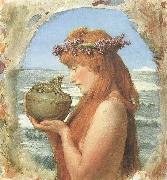 |
Sir Lawrence Alma-Tadema,OM.RA,RWS -- Click Here
|
|
1836-1912
|
|
|
|
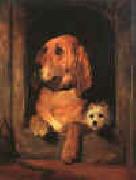 |
Sir Edwin Landseer -- Click Here
|
|
1803-1874
British
Sir Edwin Landseer Galleries
Landseer was something of a child prodigy whose artistic talents were recognized early on; he studied under several artists, including his father John Landseer, an engraver, and Benjamin Robert Haydon, the well-known and controversial history painter who encouraged the young Landseer to perform dissections in order to fully understand animal musculature and skeletal structure.
At the age of just 13, in 1815, Landseer exhibited works at the Royal Academy. He was elected an Associate of the Royal Academy at the age of 24, and an Academician of the Royal Academy five years later in 1831. He was knighted in 1850, and although elected President of the Royal Academy in 1866 he declined the invitation.
Landseer was a notable figure in 19th century British art, and his works can be found in Tate Britain, the Victoria and Albert Museum, Kenwood House and the Wallace Collection in London. He also collaborated with fellow painter Frederick Richard Lee.
Windsor Castle in Modern Times (1841-1845)
Queen Victoria and her family at Windsor Castle.Landseer's popularity in Victorian Britain was considerable. He was widely regarded as one of the foremost animal painters of his time, and reproductions of his works were commonly found in middle-class homes. Yet his appeal crossed class boundaries, for Landseer was quite popular with the British aristocracy as well, including Queen Victoria, who commissioned numerous portraits of her family (and pets) from the artist. Landseer was particularly associated with Scotland and the Scottish Highlands, which provided the subjects (both human and animal) for many of his important paintings, including his early successes The Hunting of Chevy Chase (1825-1826) and An Illicit Whiskey Still in the Highlands (1826-1829), and his more mature achievements such as the majestic stag study Monarch of the Glen (1851) and Rent Day in the Wilderness (1855-1868).
Saved (1856)
Landseer's paintings of dogs were highly popular among all classes of society.So popular and influential were Landseer's paintings of dogs in the service of humanity that the name Landseer came to be the official name for the variety of Newfoundland dog that, rather than being black or mostly black, features a mix of both black and white; it was this variety Landseer popularized in his paintings celebrating Newfoundlands as water rescue dogs, most notably Off to the Rescue (1827), A Distinguished Member of the Humane Society (1838), and Saved (1856), which combines Victorian constructions of childhood with the appealing idea of noble animals devoted to humankind ?? a devotion indicated, in Saved, by the fact the dog has rescued the child without any apparent human direction or intervention.
In his late 30s Landseer suffered what is now believed to be a substantial nervous breakdown, and for the rest of his life was troubled by recurring bouts of melancholy, hypchondria, and depression, often aggravated by alcohol and drug use (Ormond, Monarch 125). In the last few years of his life Landseer's mental stability was problematic, and at the request of his family he was declared insane in July 1872.
Landseer's death on 1 October 1873 was widely marked in England: shops and houses lowered their blinds, flags flew at half-staff, his bronze lions at the base of Nelson's column were hung with wreaths, and large crowds lined the streets to watch his funeral cortege pass (Ormond, Monarch 135). Landseer was buried in St Paul's Cathedral, London . |
|
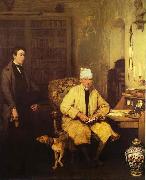 |
Sir David Wilkie -- Click Here
|
|
1785-1841
British Sir David Wilkie Galleries
Wilkie may have inherited his rectitude and tenacity, even his nervous inhibitions, from his father, the minister of his native parish. Though little responsive to schooling, he showed an early inclination towards mimicry that expressed itself in drawings, chiefly of human activity. In these he was influenced by a copy of Allan Ramsay pastoral comedy in verse, the Gentle Shepherd (1725), illustrated by David Allan in 1788. One of the few surviving examples of his early drawings represents a scene from it (c. 1797; Kirkcaldy, Fife, Mus. A.G.). Wilkie cherished the demotic spirit of this book and its illustrations throughout his life. |
|
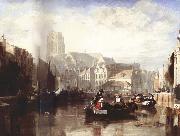 |
Sir Augustus Wall Callcott -- Click Here
|
|
1779-1844
|
|
 |
Sandro botticelli and workshop -- Click Here
|
|
Italian
c.1445-1510
|
|
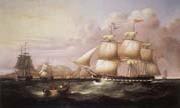 |
Samuel Walters -- Click Here
|
|
British Painter, 1811-1882 |
|
|
|
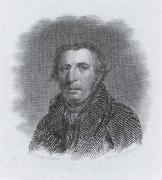 |
Samuel Lovett Waldo -- Click Here
|
|
American Painter, 1783-1861
American painter. After attending a country school and working on his father farm, he decided at the age of 16 to become an artist. He took lessons from Joseph Steward (1753-1822), a retired minister who operated a portrait studio in Hartford, CT. Waldo opened his own studio in Hartford in 1803, before moving on to paint portraits in Litchfield, CT, and Charleston, SC. In 1806, bearing letters of introduction to Benjamin West and John Singleton Copley, Waldo travelled to London, where he studied at the Royal Academy. His portrait of Mr M Dougle (untraced) was shown at the Royal Academy in 1808. |
|
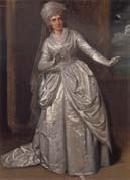 |
Samuel De Wilde -- Click Here
|
|
British 1748-1832,English painter and etcher of Dutch descent. He was the son of a Dutch joiner who had settled in London by 1748. On 19 November 1765 he was apprenticed for seven years to his godfather, Samuel Haworth, a joiner in London. However, he left after five years and enrolled as a student at the Royal Academy Schools in 1769. He exhibited small portraits at the Society of Artists (1776-8) and at the Royal Academy (from 1778), where he also showed fancy pictures of banditti in the style of Philippe Jacques de Loutherbourg. But the genre that he made very much his own was theatrical portraiture: he exhibited theatrical portraits at the Royal Academy almost every year from 1792 to 1821. |
|
|
|
|
| | |
|
|
|
|